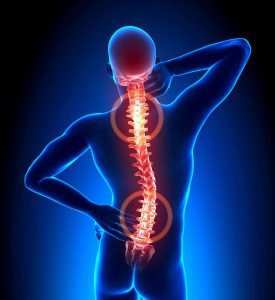Smoking? Lung Cancer Isn’t The Only Reason to Quit
- You Know Smoking is Bad, Then Why Do You Smoke?
- Back Pain
- How Does Smoking Create Back Pain?
- Quit Smoking For Good With These 7 Strategies
Smoking is bad news. Tobacco use is the leading preventable cause of death worldwide, and ditching cigarettes benefits nearly everyone.
Never mind the health consequences, which are themselves disastrous; smoking creates an incredible financial burden. The Centers for Disease Control (CDC) estimates that between 2000 and 2004, the average annual productivity losses attributable to smoking averaged about a whopping $96.8 billion.
You Know Smoking is Bad, Then Why Do You Smoke?
Despite knowing its massive risks, about 20 percent or 60 million Americans still smoke. Even if you don’t smoke, second-hand smoke can create premature death from chronic diseases, economic losses to society, and a substantial public health burden.
Cancers
You know the usual reasons to avoid lighting up. Cigarette smoking contributes to many diseases including cancer, chronic lung and vascular diseases, and oral disease. Several toxins in cigarette smoke can suppress your immune system. And certain components in cigarette smoke can create inflammation.
Weight Gain & Diabetes
Smoking also worsens insulin resistance, which sets the stage for Type 2 diabetes and all its complications.
Back Pain
While many smokers light up to take away pain – like to alleviate a stressful morning at work – smoking can actually create more pain. Studies find smokers have higher levels of pain that is expressed as fibromyalgia, back pain, and headaches.
 Here’s another reason to stop smoking: Smoking can trigger or exacerbate back pain, creating problems like degenerative lumbar spine issues. Back pain is the most common chronic painful condition in America that reduces quality of life while creating enormous financial and social burdens.
Here’s another reason to stop smoking: Smoking can trigger or exacerbate back pain, creating problems like degenerative lumbar spine issues. Back pain is the most common chronic painful condition in America that reduces quality of life while creating enormous financial and social burdens.
Americans spend about $34 billion in direct costs yearly to treat back pain. While other factors play a role – including physical activity and work environment – smoking is an often-overlooked variable for back pain.
In one study, 1,337 physicians from Johns Hopkins University followed participants, in some cases for more than 50 years. They found lower back pain was significantly associated with smoking history and hypertension, and development of lumbar spondylosis – deterioration of the lumbar portion of your spinal cord – was significantly associated with smoking history, hypertension, and high cholesterol.
And one meta-analysis found both current and former smokers have a higher (but fairly modest) prevalence and incidence of low back pain compared with folks who never smoked, and the association was stronger in adolescents than adults.
Among current daily smokers, other research shows those who smoked more cigarettes per day had a statistically higher prevalence of back pain.
How Does Smoking Create Back Pain?
 For one, nicotine makes you feel excited. After all, this powerful stimulant can alter your pain perception and threshold.
For one, nicotine makes you feel excited. After all, this powerful stimulant can alter your pain perception and threshold.
Smoking also increases circulating pro-inflammatory cytokines—these are the cells that create inflammation in your body. Smoking can increase inflammation, which contributes to nearly every disease on the planet.
While kicking the habit can reduce or eliminate back pain, you might consider visiting a chiropractor or other healthcare professional if you experience this condition or if you still have back pain after quitting smoking.
Even with its incentive of alleviating back pain and so many other conditions, quitting can be extremely difficult. After all, nicotine is a powerful stimulant that affects neurotransmitters like dopamine, involved in the rewarding and reinforcing effects of nicotine. Dopamine plays a key role in making nicotine so addictive.
Whereas alcoholics experience withdrawal when they give up booze, stimulants like nicotine trigger cravings – making you irritable and intensely want to smoke.
Quit Smoking For Good With These 7 Strategies
Most people require several tries before smoking cessation becomes permanent. These seven strategies can help.
- Steady your blood sugar levels. Studies show smoking suppresses appetite, and that cigarette smokers are overall less likely to have reduced-body weight compared with non-smokers. When you stop smoking, you’re likely to gain weight. High-sugar foods stimulate dopamine just like nicotine does, so don’t trade one bad habit for another. Instead, keep your blood sugar levels steady by eating nutrient-dense meals that are low in carbohydrates and rich in healthy omega-3 fatty acids and protein.
 Eat from the rainbow. Among its damage, smoking triggers oxidative stress, allowing free radicals to accumulate that contribute to health issues including Type 2 diabetes. Researchers find smokers eat fewer fruits and vegetables than non-smokers, plummeting their already-lower antioxidant levels. Eating a wide variety of colorful plant foods – leafy and cruciferous vegetables and berries are rock stars – can help reverse smoking’s damage and replenish antioxidant levels.
Eat from the rainbow. Among its damage, smoking triggers oxidative stress, allowing free radicals to accumulate that contribute to health issues including Type 2 diabetes. Researchers find smokers eat fewer fruits and vegetables than non-smokers, plummeting their already-lower antioxidant levels. Eating a wide variety of colorful plant foods – leafy and cruciferous vegetables and berries are rock stars – can help reverse smoking’s damage and replenish antioxidant levels.- Manage stress. While many people reach for a cigarette to smoke to alleviate stress, research shows smoking actually increases stress levels. Regardless, you’ve probably used smoking to remedy stress, and you’ll need to find something else to alleviate those feelings now that you no longer smoke. Find a support group that keeps you committed to quitting. Meditation, yoga, deep breathing, Emotional Freedom Technique (EFT), exercise – these are among the tools to reduce stress, but you’ve got to find what works for you and do it regularly.
 Get moving. Studies show brief moderate-intensity exercise can rapidly lower your desire to smoke and lessen the miseries of withdrawal. Besides, after an invigorating workout, are you going to want a cigarette and undo that hard work? In less time than you took for smoke breaks throughout the day, you can incorporate about 20 minutes of high-intensity interval training (HIIT) to get your heart and lungs pumping.
Get moving. Studies show brief moderate-intensity exercise can rapidly lower your desire to smoke and lessen the miseries of withdrawal. Besides, after an invigorating workout, are you going to want a cigarette and undo that hard work? In less time than you took for smoke breaks throughout the day, you can incorporate about 20 minutes of high-intensity interval training (HIIT) to get your heart and lungs pumping.- Sleep deeper. Relapse is the biggest problem for ex-smokers, and research shows sleep deprivation makes an easy path to fall back on smoking. One study associated nicotine-dependence symptoms and poor sleep among young smokers. Besides, you’re more likely to make more poor choices overall when you don’t sleep well. As you gravitate to healthier choices, prioritize eight hours of sleep nightly. You will probably find it helps you to quit smoking.
- Nutrients that support quitting. Rebalancing neurotransmitters like serotonin and dopamine can reduce cravings for nicotine and food. Among the nutrients that help rebalance include tyrosine and 5-HTP as well as adaptogenic herbs like Rhodiola. Some formulas contain synergistic blends of these and other nutrients to balance neurotransmitters and reduce cravings. You might consider working with a MaxLiving Chiropractor who has a nutrition certification and can recommend supplements that will benefit you.
Get support. Among action steps to kick the habit for good, researchers recommend looking at critical emotions and situations where you feel you need to smoke to cope (maybe you crave a cigarette after a fight with your partner). Find activities to replace the act of lighting up a cigarette and mentally preparing for craving so you can avoid smoking. A support team can help. Ask your family for help, ask a friend or coworker to keep cigarettes away from you, and join a support group if you need it.


